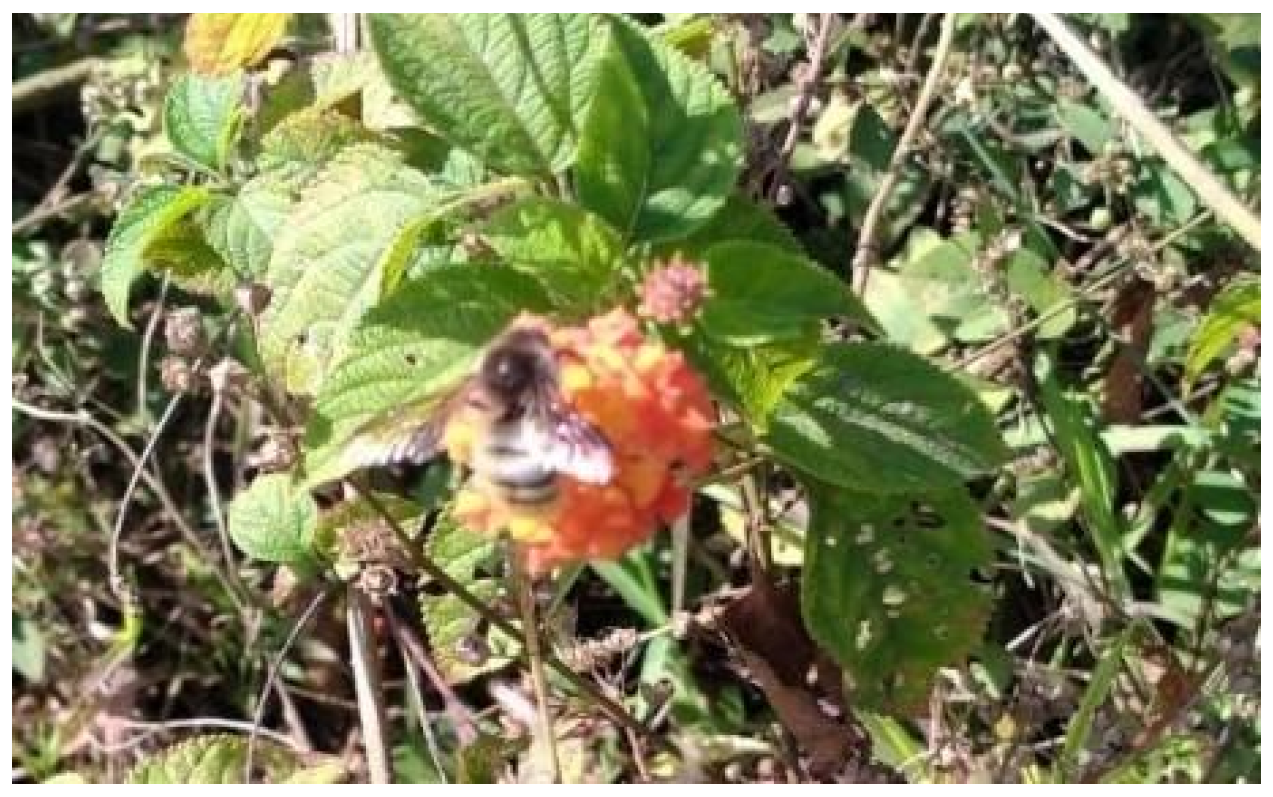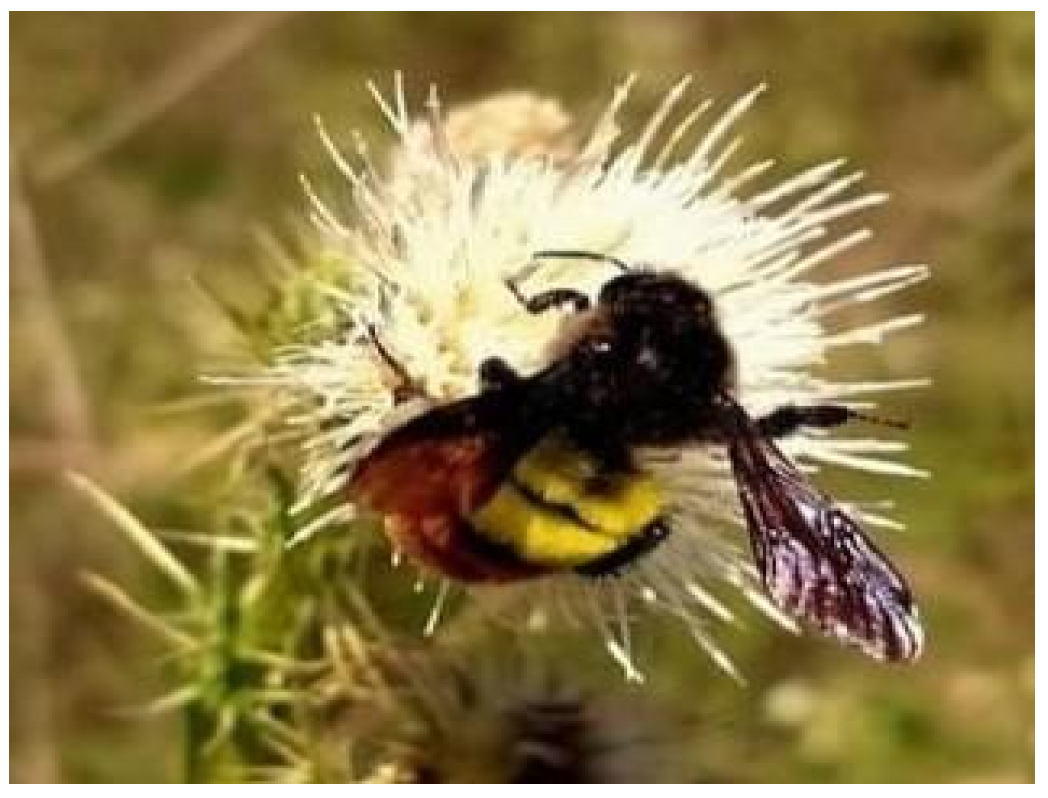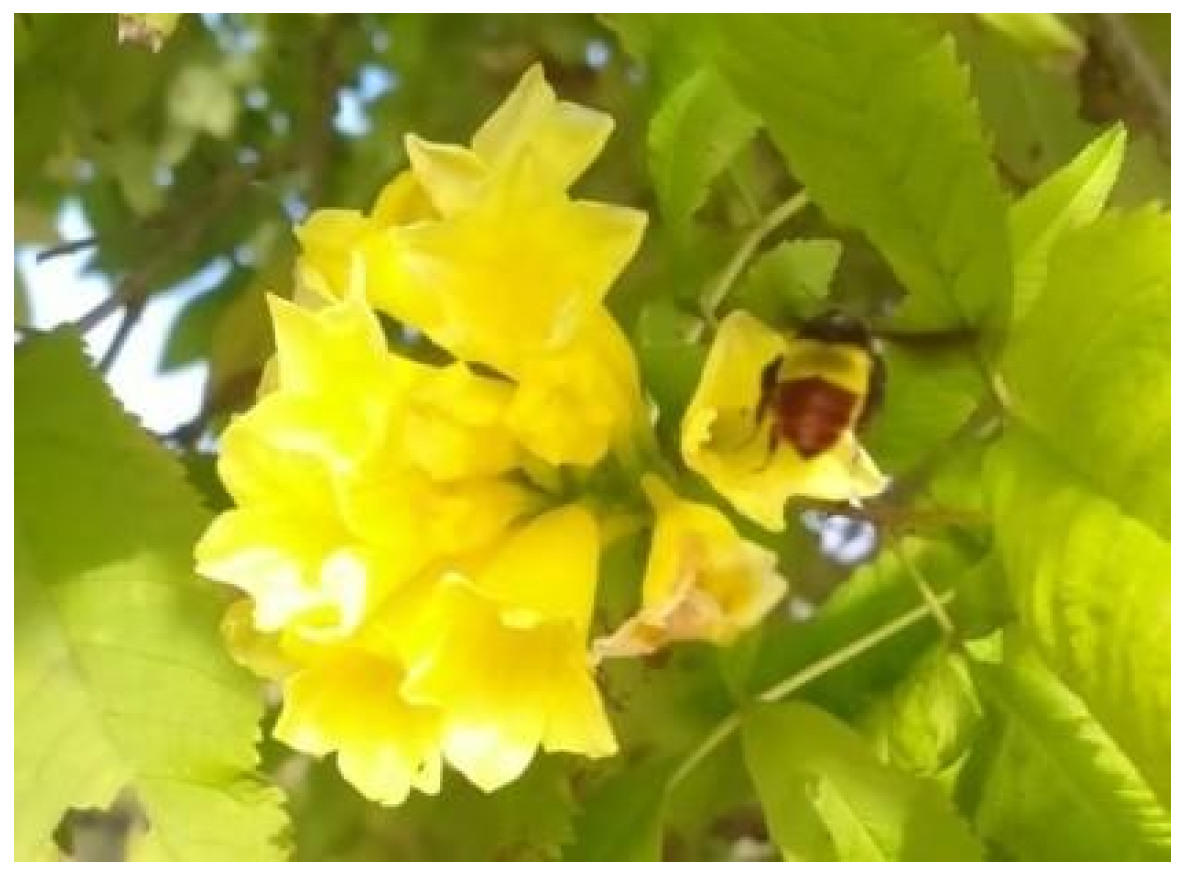1. Introduction
Insects are the most diverse group within the animal kingdom. They are important indicators for assessing, managing and monitoring biodiversity in natural ecosystems. The Hymenoptera is the second largest group of insects, which includes bees and wasps. They are not only the most successful plant pollinators, but also help in protecting plant diversity in nature and increase the productivity of different agriculture and horticulture products such as crops, vegetables and fruits. Bees and wasps play an important role in the pollination of plant species, fulfilling the requirements of animals as well as humans and their livelihood. There are 12,605 species of Hymenoptera in India, out of which 4872 are found in the Indian Himalayas. A total of 337 bee species were found in the Indian Himalayas. The world bumblebee fauna consists of approximately 250 known species [
1,
2], out of which 49 species of bumblebees have been reported from this region [
3]. In the Himalayan region, the general bumblebee distribution starts from 400 m to 5600 m [
4]. They are most abundantly distributed in the mountains to the east of Tibet and in the mountains of central Asia [
1].
The Himalayas, the longest mountain range in the world, is home to a high bumblebee diversity due to its variety of suitable habitats. Their important attributes like short flight range, cold hardiness and high elevation adaptation make them important pollinators of wild and agricultural flowering plants and crops with both ecological and economic importance [
5]. They are efficient pollinators, as their large and fuzzy body can carry a larger load of pollen than any other bee. Because of their thermoregulatory abilities, they can thrive well in the high altitude and cold ambient temperatures of the Himalayan region, and can carry out pollination when no other bee is able to. They are generalist foragers and can forage on a wide range of plants. Their distribution is dependent on the abundance of their floral resources [
6]. Bumblebees are also used for the pollination of tomatoes and other Solanaceous crops in greenhouses [
6,
7,
8] and some leguminous crops too. However, some plants rely on bumblebees to achieve pollination. The loss of bumblebees could have wide-ranging ecological impacts due to their role as pollinators. Around the world, bumblebee numbers are declining due to a number of factors, such as anthropogenic activities, habitat loss, climate change, excessive pesticide uses, the introduction of invasive bees, overgrazing of foraging plants, etc. Studies have shown that the decline in bumblebee numbers is also a result of the decline in plants pollinated by them.
2. Materials and Methods
A preliminary study on the foraging behavior of Bombus haemorrhoidalis Smith was conducted in Doon valley, Dehradun, Uttarakhand, which is surrounded by agroecosystems and subtropical temperate landscapes situated at the foothills of the outer Himalayan region, with an altitudinal gradient of 640 m amsl. The study was conducted from October 2020 to April 2021. It was conducted covering four different habitats, including fields, a forest area and semiurban areas of Doon valley.
The insects were collected from the study areas using systematic net sweeps. They were collected in special transparent killing jars, so as to preserve the color of the pubescence, as the color of the pubescence in bumblebees holds great importance in the identification of species. After coming to the laboratory, the specimens were pinned with the help of entomological pins of different sizes, keeping in view the size of the specimens. After stretching, the specimens were appended with a data label containing important information regarding their locality, altitude, date of collection and name of the collector. Later on, the stretched specimens were transferred to storage boxes, poisoned with ethyl-acetate-soaked cotton and naphthalene powder filling in the side grooves of the boxes.
The collected samples were examined under a stereoscopic microscope in the laboratory and identified using published keys for adjoining areas, e.g., Nepal [
3], India [
9] and Kashmir [
10].
3. Results and Discussion
Bumblebees were most active during the early morning and late noon hours during summer, and during winter, they were active during late morning till early evening time. They were more active than any other bees, such as honeybees, during winter, and could be seen foraging on the available flowering plants. They are generalist foragers and they can efficiently pollinate from late winter (February) to late autumn (November). In the months of October and November, they were very abundant, and during winter (December–January), their abundance declined due to a lower availability of foraging plants, but even then, they were more active than other bees. From early spring (March onwards), their activity increased with the abundance of foraging plants. Since they are active for so many months, they must be able to forage on a wide range of plant species. Their abundance significantly depends on the temperature and weather conditions of that particular area. There was a positive correlation between the foraging of bumblebees and humidity, because nectar secretion rates were higher at high humidity. It was also observed that bumblebees avoided collecting pollen when the foliage was covered in dew or rain-water droplets, which would make grooming pollen into the corbiculae harder [
11].
Bombus haemorrhoidalis was the predominant species of the genus Bombus in Doon valley. Its preferred foraging plant species during the studied period were
Lantana sp. (Verbenaceae) (
Figure 1),
Cirsium arvense (Asteraceae) (
Figure 2),
Tecoma stans (Bignoneaceae) (
Figure 3),
Tropaeolum majus (Tropaeolaceae) and
Solanum melongena (Solanacea). Their foraging activity depends on the seasonal availability of floral resources in the study area.
Author Contributions
Sample collection and foraging study has been done by A.P. Editing and review has been done by V.P.U. All authors have read and agreed to the published version of the manuscript.
Funding
This work has been funded by National Mission for Clean Ganga (NMCG) project, Govt. of India.
Institutional Review Board Statement
The institute does not have any ethical committee.
Informed Consent Statement
Not applicable.
Data Availability Statement
Not applicable.
Conflicts of Interest
The authors declare no conflict of interest.
References
- Williams, P.H. Phylogenetic relationships among bumble bees (Bombus Latr.): A reappraisal of morphological evidence. Syst. Entomol. 1994, 19, 327–344. [Google Scholar] [CrossRef]
- Williams, P.H. An annotated checklist of bumble bees with an analysis of patterns of description (Hymenoptera: Apidade, Bombini). Bull. Nat. Hist. Mus. 1998, 67, 79–152. [Google Scholar]
- Zoological Survey of India. Fauna of Uttarakhand; State Fauna Series; Part-2; Zoological Survey of India: Kolkata, India, 2010; Volume 18, pp. 691–748.
- Williams, P.H.; Ito, M.; Matsumura, T.; Kudo, I. The bumblebees of the Nepal Himalaya (Hymenoptera: Apidae). Insecta Matsumurana 2010, 66, 115–151. [Google Scholar]
- Streinzer, M.; Chakravorty, J.; Neumayer, J.; Megu, K.; Narah, J.; Schmitt, T.; Bharti, H.; Brockmann, A. Species composition and elevational distribution of bumble bees (Hymenoptera, Apidae, Bombus Latreille) in the East Himalaya, Arunachal Pradesh, India. ZooKeys 2019, 851, 71–89. [Google Scholar] [CrossRef] [PubMed]
- Dramstad, W.; Fry, G. Foraging activity of bumblebees (bombus) in relation to flower resources on aerable land. Agric. Ecosyst. Environ. 1995, 53, 123–135. [Google Scholar] [CrossRef]
- Banda, H.J.; Paxton, R.J. Pollination of greenhouse tomatoes by bees. Acta Horti. 1991, 288, 194–198. [Google Scholar] [CrossRef]
- Kevan, P.G.; Straver, W.A.; Offer, M.; Laverty, T.M. Pollination of greenhouse tomatoes by bumblebees in Ontario. Proc. Entomol. Soc. Ontario. 1991, 122, 15–19. [Google Scholar]
- Saini, S.M.; Raina, R. Species diversity of Bumblebee (Hymenoptera: Apidae) from different mountain regions of Kashmir Himalayas. J. Sci. Res. 2012, 4, 263–272. [Google Scholar] [CrossRef]
- Williams, P.H. The bumblebees of the Kashmir Himalaya (Hymenoptera: Apidae, Bombini). Bull. Br. Mus. 1991, 60, 1–204. [Google Scholar]
- Peat, J.; Goulson, D. Effects of experience and weather on foraging rate and pollen versus nectar collection in the bumblebee, Bombus terrestris. Behav. Ecol. Sociobiol. 2005, 58, 152–156. [Google Scholar] [CrossRef]
| Publisher’s Note: MDPI stays neutral with regard to jurisdictional claims in published maps and institutional affiliations. |
© 2022 by the authors. Licensee MDPI, Basel, Switzerland. This article is an open access article distributed under the terms and conditions of the Creative Commons Attribution (CC BY) license (https://creativecommons.org/licenses/by/4.0/).







